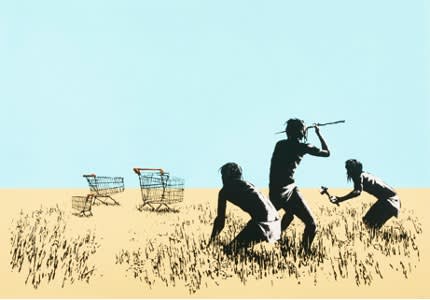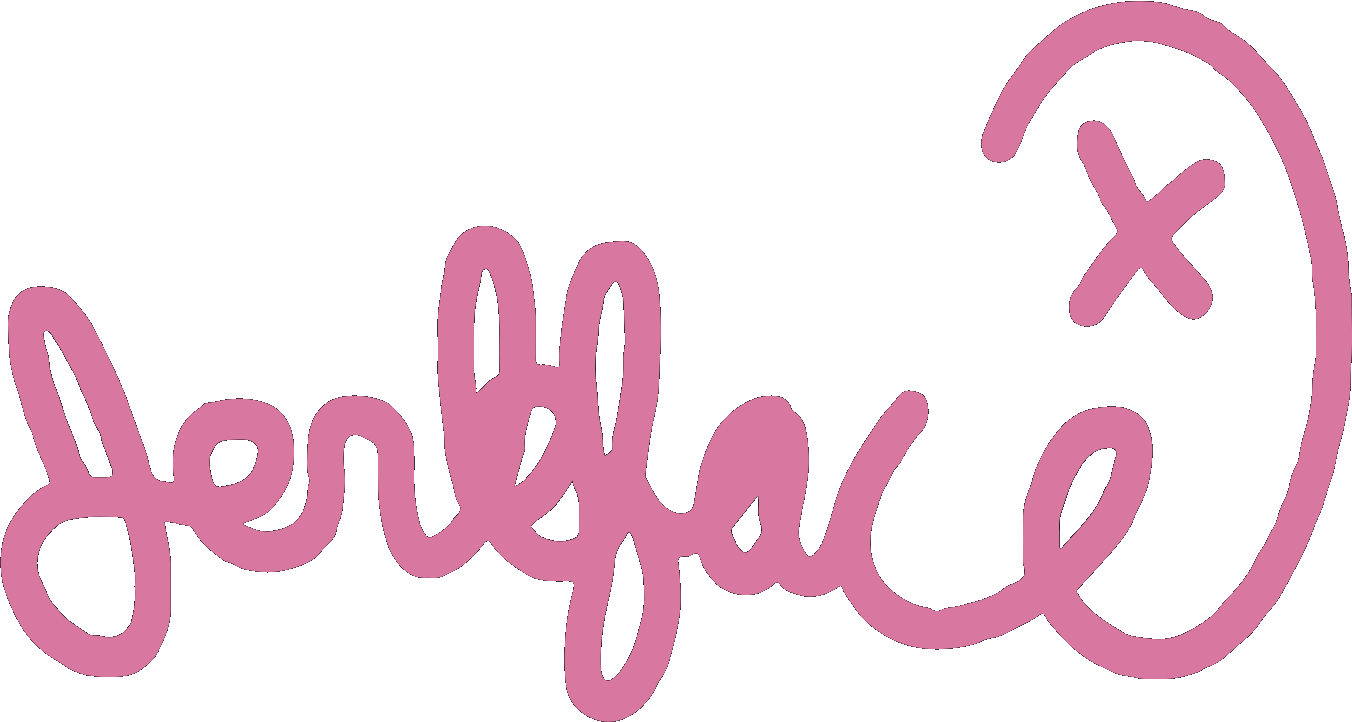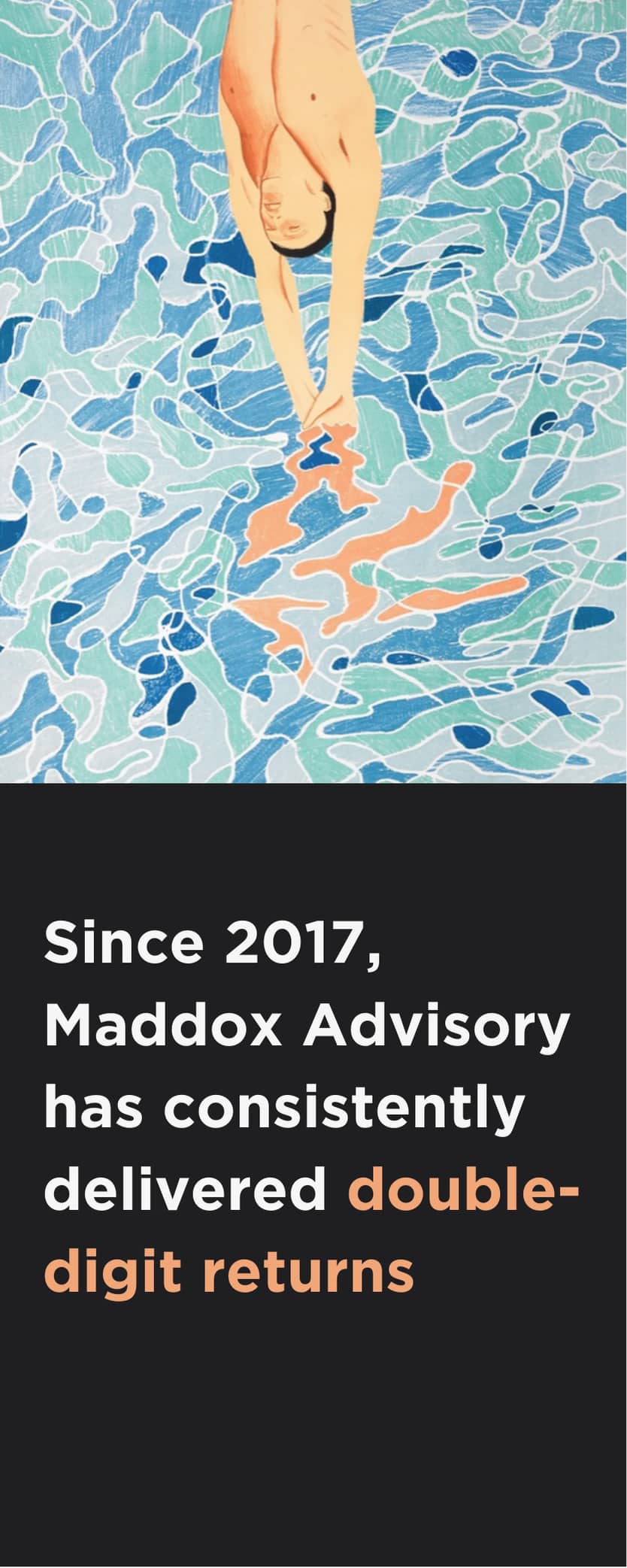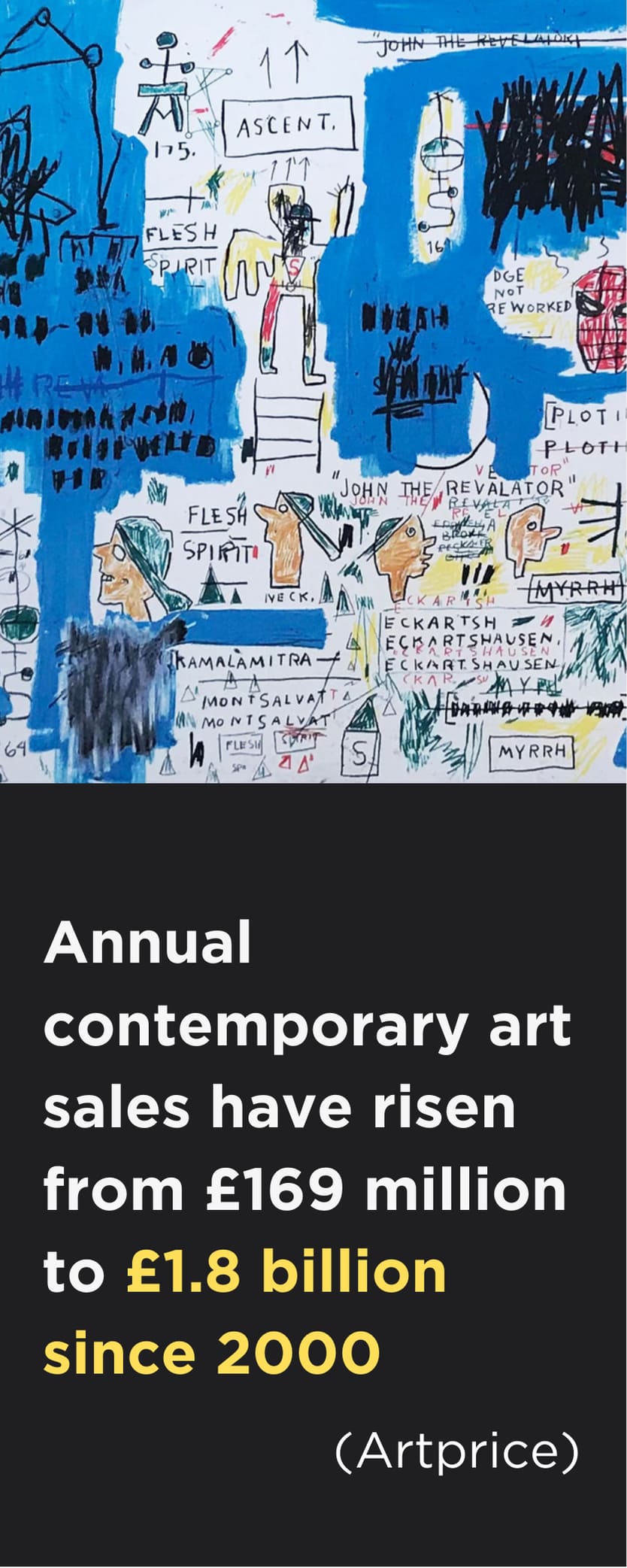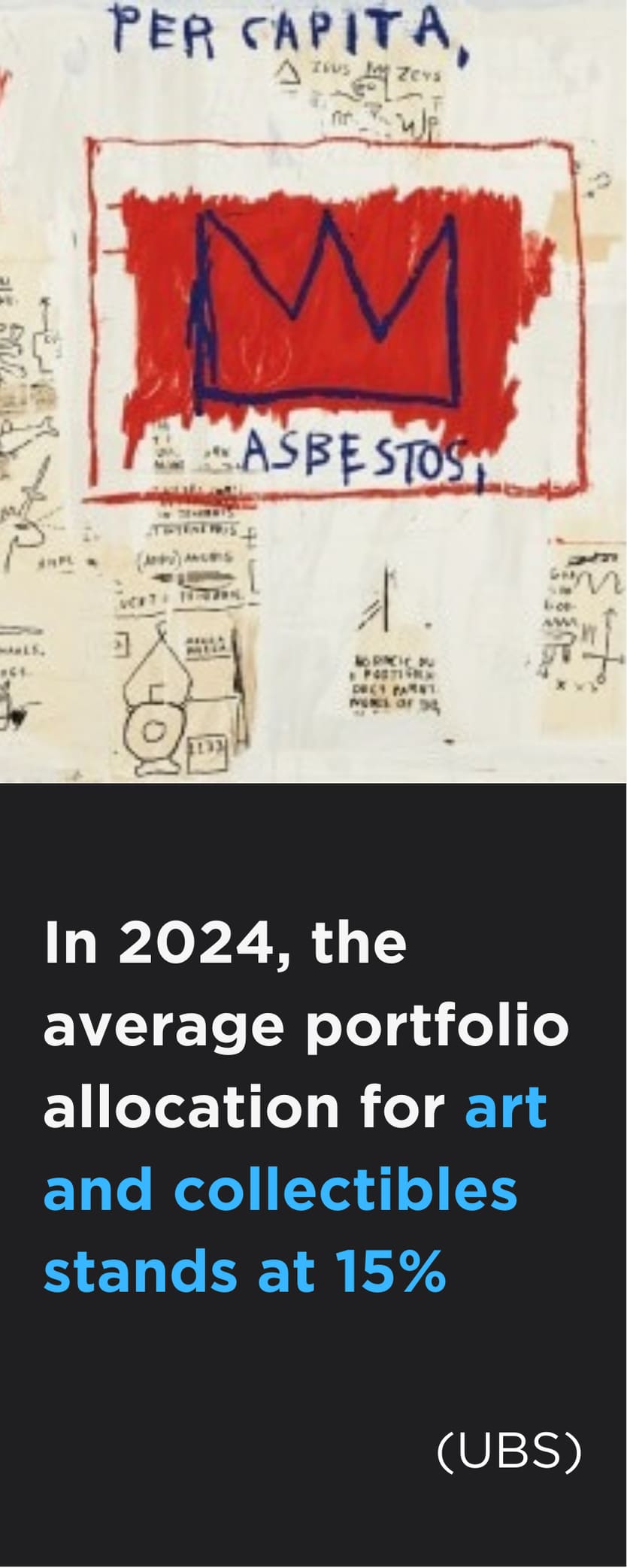Witty, subversive and brilliantly uncomfortable, the art of Banksy is rooted in irony and impact. This article explores how Banksy humour disarms and provokes in equal measure, revealing the sharp cultural commentary beneath the surface. From visual puns to bold critique, welcome to the satirical world of Banksy political art.
The Art of Banksy Humour: The Subversive Smile
Flying Copper (Signed), 2004, Screenprint, Edition of 150
Banksy’s art has always walked a fine line between comedy and controversy. His wit is as sharp as his stencils, delivering punchlines that make you laugh—then make you squirm. Whether it’s a riot police officer sporting a yellow smiley face or a protester hurling a bouquet instead of a Molotov, funny Banksy art is never just for laughs. It’s a tool, a weapon, a way of exposing difficult truths under the guise of a joke.
It’s time to get comfortable with being uncomfortable because Banksy satire doesn’t exist for easy amusement. His humour is subversive by design, disarming us with irony before revealing the brutal reality beneath. A child letting go of a heart-shaped balloon isn’t just a sentimental image—it’s a meditation on loss. A Banksy monkey wearing a sign that reads “Laugh now, but one day we’ll be in charge” isn’t just a joke—it’s a warning.
From clever wordplay to audacious visual gags, his work exposes the absurdities of politics, power and the art world itself. In an era where satire is often softened for mass appeal, his remains defiantly sharp—unapologetic, provocative and impossible to ignore. But what is it about his unique brand of Banksy humour that continues to captivate collectors and critics alike? Let’s dive into the art of Banksy, where every smile comes with a sting.
Signature Banksy Irony: Using British Humour as a Cultural Lens
Monkey Queen (Unsigned), 2003, Screenprint, Edition of 750
Banksy satire provokes with a distinctly British flavour. His art is laced with irony, deadpan wit and a deep appreciation for the absurd, echoing the great British tradition of using humour to highlight the harsh reality. From Orwell's sharp-edged dystopian critiques to the surreal, anarchic irreverence of Monty Python, Britain has long been home to satire that cuts through the noise of politics and power. Banksy is very much a part of this lineage. His work doesn’t just mock authority; it exposes the absurdity of the systems that uphold it.
Take his infamous Devolved Parliament, one of the best-known Banksy monkey artworks, which replaces politicians with chimpanzees in the House of Commons. It’s both a joke and a brutal statement about the state of British politics—funny until you realise how painfully close to the truth it is. Or consider Sale Ends, a haunting image of kneeling figures in a pose of religious devotion, not in front of a deity but a bright-red SALE ENDS TODAY sign. This caustic critique of consumerism turns the fervour of worship into a biting commentary on our obsession with possessions. These works don’t just amuse; they force us to confront the contradictions in the systems that shape our lives—whether it’s politics, capitalism or the culture of consumption itself.
At its core, Banksy humour is the type that Britain does best: dry, subversive and unafraid to turn its wit on itself. Funny Banksy art isn’t about sanitised laughs—it’s the kind of satire that lingers, making you chuckle while leaving you with a nagging sense of unease. In a time of political chaos and cultural division, his state-of-the-nation commentary feels more relevant than ever, reminding us that sometimes, the most unsettling truths are best delivered with a wry smile.
Laugh First, Reflect Later: The Banksy Political Punchline
Napalm (Unsigned), 2004, Screenprint, Edition of 500
Banksy’s best political works are like well-crafted jokes. They land with a laugh, then leave you thinking long after the punchline. More than just a tool for entertainment. they draw the viewer in with wit before delivering a cutting critique of politics, power and authority.
Take Napalm, where Banksy reimagines the harrowing photograph of a naked Vietnamese girl fleeing a napalm attack, except in his version she’s flanked by the cheery mascots of Ronald McDonald and Mickey Mouse. It’s a jarring contrast that exposes the dark underbelly of Western consumerism, using satire to highlight the unsettling link between corporate influence and global suffering. You might smirk at first, but the longer you look, the more disturbing it becomes.
Or consider Flag, Banksy’s reinterpretation of the famous image of US soldiers raising the flag at Iwo Jima. In his version, the soldiers are replaced with children scrambling to hoist an American flag atop a burnt-out car, surrounded by urban decay. It’s a stark commentary on inner-city poverty, nationalism and the misplaced priorities of modern society. The visual irony is immediate, but the implications run deep.
Then there is Applause, a darkly humorous piece of Banksy politics that places an audience prompter—like those used in television studios—against a scene of fighter jets on an aircraft carrier, as if war itself is just another spectacle. It mocks the way conflict is often presented as entertainment, urging us to question how desensitised we’ve become to violence when it’s packaged for public consumption.
For collectors, these layers of meaning are what elevate Banksy political art beyond street art, transforming it into powerful cultural artefacts. His pieces don’t just document political issues; they distill them into instantly recognisable, thought-provoking images that hold lasting relevance. Whether you laugh first and reflect later—or the other way around—Banksy ensures his message lingers long after the paint has dried.
Banksy Satire Meets the Market: Capitalism, Consumerism and the Art World
Morons (2007), Screenprint, Edition of 500
No one lampoons the art market quite like Banksy, yet no one thrives within it quite like him either. His work skewers capitalism, mocks the commodification of art and exposes the absurdity of consumer culture. And yet the irony is impossible to ignore: the more he ridicules the art world, the more people clamour to buy Banksy art. Banksy politics isn’t just a critique of capitalism—it’s a paradox that fuels the very market he derides.
Few pieces capture this contradiction better than Morons, a work that takes aim at the speculative frenzy of art buyers. Originally appearing as a screenprint, the piece riffs on a historic Christie’s auction scene, with bidders eagerly vying for a framed artwork that reads: "I can’t believe you morons actually buy this shit." By replacing the reverence of an auction with brutal honesty, the work has—despite, or perhaps because of, its message—become a sought-after collector’s item, proving Banksy’s point in real time.
Equally biting is Very Little Helps, where a group of children raise a Tesco-branded plastic bag as if it were a national flag. It’s a scathing indictment of corporate dominance and the way consumerism has seeped into everyday life, replacing traditional values with brand loyalty. The imagery is simple, yet it cuts deep, highlighting the way modern society, and even childhood itself, is shaped by the omnipresence of big business.
Very Little Helps (Signed), 2008, Screenprint, Edition of 299
Then there is the infamous shredding stunt at Sotheby’s London in 2018, arguably the greatest piece of performance art ever staged at an auction house. When Girl with Balloon sold for over £1 million, an internal mechanism within the frame activated, slicing the artwork into strips the moment the hammer fell. The result? A newly rebranded piece, Love is in the Bin, that instantly doubled in value. It was Banksy irony at its most subversive that turned a critique of the art world into a headline-grabbing spectacle, only reinforcing his market appeal.
And who can forget Dismaland, Banksy’s dystopian, anti-capitalist "bemusement park" that took aim at corporate entertainment, branding and the hollow promises of mass consumer culture. With its crumbling fairground rides, grim reimaginings of Disney characters and bleak social commentary, the project was a massive, immersive Banksy parody, further cementing him as one of the finest political satire artists of our time. Ironically, it was also a commercial success, drawing thousands of visitors and further solidifying Banksy’s grip on the art market.
For collectors, these works offer something only Banksy can offer: enormous market appeal, wrapped in a generous dose of controversy. Owning a Banksy isn’t just about acquiring art—it’s about owning a slice of the cultural conversation.
Banksy Irony and Empathy: The Humanist Thread in Banksy’s Work
Flower Thrower Triptych (2019), Screenprint, Edition of 300
While the art of Banksy is renowned for its biting satire, a closer examination reveals a profound social conscience woven throughout. Beyond the irony and wit lies a deep empathy for marginalised communities, particularly refugees and the homeless. This duality—sharp critique paired with heartfelt compassion—renders Banksy's work both enduring and emotionally compelling for collectors.
In 2015, amidst the European migrant crisis, Banksy unveiled The Son of a Migrant from Syria in the Calais Jungle refugee camp. The mural depicts Steve Jobs, the late co-founder of Apple and son of a Syrian migrant. Carrying a sack over his shoulder and holding an early Apple computer, this powerful image challenged prevailing narratives about refugees, emphasising their potential contributions to society. Furthering his advocacy, Banksy funded and decorated the MV Louise Michel, a rescue boat dedicated to saving refugees in the Mediterranean Sea.
Banksy's empathy extends to the homeless, as evidenced by his mural in Birmingham, created in December 2019. The artwork features two reindeer pulling a bench carrying a rough sleeper as a makeshift sleigh. By integrating the bench into the mural, Banksy drew attention to the plight of the homeless, urging viewers to reflect on societal neglect during the festive season.
One of the latest examples of Banksy activist art appeared at London Zoo in 2024: a mural featuring a gorilla lifting a shutter, freeing animals—including birds and a seal—from captivity. Blending the artist's characteristic irony with a call for empathy towards all sentient beings, it formed part of an “animal art trail” that appeared across London over the course of just a few days.
While the imagery may be playful, its message is deeply humanist. The art of Banksy has always been about more than just provocation—it’s about compassion, solidarity and giving a voice to the voiceless. Whether addressing human suffering or the rights of animals, his murals often serve as quiet acts of resistance, urging viewers to consider the lives that exist on the margins of society.
Maeve Doyle, Artistic Director at Maddox Gallery, discussed this mural's significance in an interview on BBC World News the day after its discovery: “Banksy’s international appeal is because he works with metaphors and symbols that are universal,” she said. “He’s inclusive. That’s the job of the artist—not to exclude, but to include.” This ethos, using art to highlight injustice while fostering empathy, is what makes Banksy satire so enduring. Whether painting on the walls of refugee camps, transforming benches into statements on homelessness or turning the urban landscape into a plea for animal welfare, beneath the wit and rebellion lies something more powerful: a call to care.
Banksy Politics, Cultural Commentary and Collector Appeal
I Fought The Law (Unsigned), 2004, Screenprint, Edition of 500
Banksy is more than just an artist—he’s a cultural phenomenon. His work exists at the crossroads of satire, politics and social critique, making it not only visually arresting but intellectually compelling. With each new mural, stunt or intervention, he sparks conversation, challenges authority and reinforces his status as both a rebel and an icon. This duality—subversive yet highly sought-after, critical of capitalism yet a blue-chip favourite—is precisely what makes his work so unique.
At the heart of Banksy politics is an unfiltered critique of power, consumerism and inequality. Whether he’s mocking the art market or amplifying social issues, Banksy political art resonates because it distills complex realities into instantly recognisable, thought-provoking images. His uncanny ability to blend satire with empathy ensures his art lingers in both the public consciousness and the collector’s market.
Yet for all his anti-establishment energy, the art of Banksy is some of the most in-demand in the world. His shredded painting stunt at Sotheby’s not only critiqued the art market but also reinforced his own value within it, proving that his work isn’t just commentary—it’s part of the very system he satirises. This paradox is what makes Banksy’s appeal so potent. He isn’t just an artist, he’s a social critic with a razor-sharp sense of irony, a disruptor whose work continues to break records and command global attention.
Choose Your Weapon - White (2010), Screenprint, Edition of 25
For collectors, acquiring a Banksy means owning a piece of cultural history—a conversation starter, a statement, a piece of rebellion captured in spray paint and stencils. Few artists balance wit, relevance and market appeal quite like Banksy. Always surprising, always topical, this is why he remains one of the most exciting figures in Contemporary art.
Explore our portfolio of iconic Banksy prints and originals and discover why Banksy remains one of the most compelling artists in the contemporary market today.
Conclusion
Is Banksy funny? Not in the traditional sense. Unlike many funny artists, his humour isn’t light-hearted or escapist; it’s sharp, subversive, and often uncomfortably revealing. His unique brand of Banksy comedy invites a smirk, but that smirk quickly fades as the deeper message sets in.
Whether mocking politics, corporate greed or the art world itself, his wit is always laced with intent. His murals highlight society’s blind spots with a mix of irony and empathy. His anti-capitalist art critiques consumer culture while paradoxically thriving within the very market he ridicules. His political works expose the absurdities of power, offering moments of dark humour that reveal uncomfortable truths.
This ability to balance wit with weight, rebellion with resonance and satire with sincerity is what makes Banksy one of the most compelling figures in Contemporary art. His humour may begin with a laugh, but it rarely ends there. The joke is always on us—and we keep paying for the punchline.
Interested in acquiring Banksy artwork? For collectors seeking standout Contemporary pieces with cultural impact, our expert team at Maddox Gallery would be delighted to assist with sourcing and private viewings.
